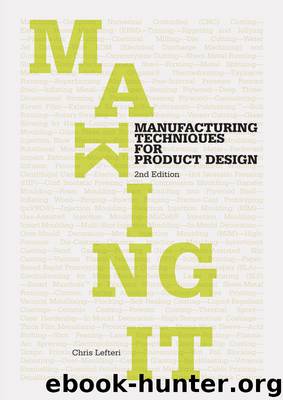Making It by Lefteri Chris

Author:Lefteri, Chris
Language: eng
Format: epub
Publisher: Laurence King Publishing
– Excellent definition in detailing.
– Generates a uniform thickness of metal.
– Low tooling costs.
– An easy way to replicate existing products.
– High tolerance.
– Fairly slow and thus expensive.
Volumes of production
Due to the length of time it takes to load molds into the tank and produce the buildup of metal, this is not a process for high-volume or rapid production.
Unit price vs. capital investment
This is an economical way of reproducing designs that are intricately patterned without needing a large investment in tooling. The cost of electroforming is partly determined by the amount of metal used, so the final unit price will depend on the surface area of the mold and the thickness of the deposited metal.
Speed
Slow, but depends on the amount of metal to be deposited.
Surface
Due to the nature of this process (the fact that it uses a mold and parts are built up gradually from tiny ions), the surface pattern can be highly intricate.
Types/complexity of shape
An ideal process for making multiple units of complex, highly decorative shapes. Making the mold from materials such as wax, which can be melted out after electroforming, means undercuts are possible.
Scale
The only limitation is the size of the electrolyte bath that holds the mold.
Tolerances
Unlike other metal-forming techniques, electroforming can produce extremely high tolerances, where the buildup of material is exactly the same anywhere on the part. This is unlike when a piece of metal is bent, a process that creates thick areas of material in corners.
Relevant materials
Nickel, gold, copper, alloys such as nickel-cobalt, and other electroplateable alloys.
Typical products
A great deal of highly decorated, hollow Victorian silver tableware was produced using the technique. Today, it is still used for highly detailed silverware, but it is also used for technical laboratory apparatus and in musical instruments—a French horn, for example.
Similar methods
Simple electroplating, and as part of the micro-molding with electroforming process (see p.250).
Sustainability issues
One of the major concerns with electroforming lies in the use of toxic substances in the electrolyte solution. However, systems have been introduced in which a special cleaning process removes any chemicals and metals from the water, which enables it to be recycled back into the process to reduce waste. Despite this, electroforming is still energy intensive as it based upon the use of a continuous electrical charge and so has relatively slow production rates.
Further information
www.aesf.org
www.drc.com
www.ajtuckco.com
www.finishing.com
www.precisionmicro.com
Download
This site does not store any files on its server. We only index and link to content provided by other sites. Please contact the content providers to delete copyright contents if any and email us, we'll remove relevant links or contents immediately.
Whiskies Galore by Ian Buxton(41489)
Introduction to Aircraft Design (Cambridge Aerospace Series) by John P. Fielding(32857)
Small Unmanned Fixed-wing Aircraft Design by Andrew J. Keane Andras Sobester James P. Scanlan & András Sóbester & James P. Scanlan(32534)
Craft Beer for the Homebrewer by Michael Agnew(17902)
Turbulence by E. J. Noyes(7660)
The Complete Stick Figure Physics Tutorials by Allen Sarah(7097)
Kaplan MCAT General Chemistry Review by Kaplan(6548)
The Thirst by Nesbo Jo(6406)
Bad Blood by John Carreyrou(6245)
Modelling of Convective Heat and Mass Transfer in Rotating Flows by Igor V. Shevchuk(6201)
Learning SQL by Alan Beaulieu(5994)
Weapons of Math Destruction by Cathy O'Neil(5779)
Man-made Catastrophes and Risk Information Concealment by Dmitry Chernov & Didier Sornette(5593)
Digital Minimalism by Cal Newport;(5325)
Life 3.0: Being Human in the Age of Artificial Intelligence by Tegmark Max(5144)
iGen by Jean M. Twenge(5125)
Secrets of Antigravity Propulsion: Tesla, UFOs, and Classified Aerospace Technology by Ph.D. Paul A. Laviolette(4860)
Design of Trajectory Optimization Approach for Space Maneuver Vehicle Skip Entry Problems by Runqi Chai & Al Savvaris & Antonios Tsourdos & Senchun Chai(4807)
Electronic Devices & Circuits by Jacob Millman & Christos C. Halkias(4698)
